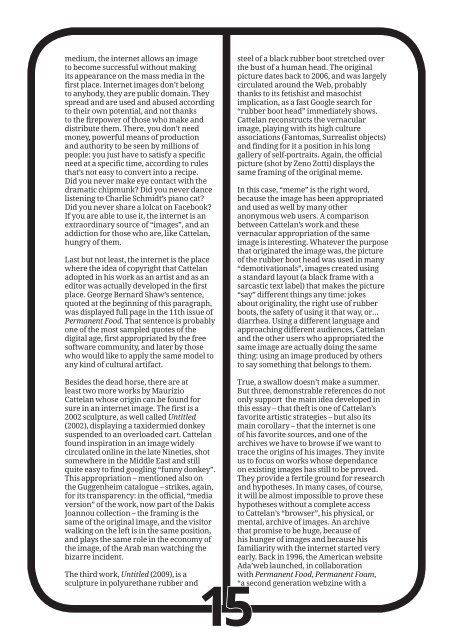You also want an ePaper? Increase the reach of your titles
YUMPU automatically turns print PDFs into web optimized ePapers that Google loves.
medium, the internet allows an imageto become successful without makingits appearance on the mass media in thefirst place. Internet images don’t belongto anybody, they are public domain. Theyspread and are used and abused accordingto their own potential, and not thanksto the firepower of those who make anddistribute them. There, you don’t needmoney, powerful means of productionand authority to be seen by millions ofpeople: you just have to satisfy a specificneed at a specific time, according to rulesthat’s not easy to convert into a recipe.Did you never make eye contact with thedramatic chipmunk? Did you never dancelistening to Charlie Schmidt’s piano cat?Did you never share a lolcat on Facebook?If you are able to use it, the internet is anextraordinary source of “images”, and anaddiction for those who are, like Cattelan,hungry of them.Last but not least, the internet is the placewhere the idea of copyright that Cattelanadopted in his work as an artist and as aneditor was actually developed in the firstplace. George Bernard Shaw’s sentence,quoted at the beginning of this paragraph,was displayed full page in the 11th issue ofPermanent Food. That sentence is probablyone of the most sampled quotes of thedigital age, first appropriated by the freesoftware community, and later by thosewho would like to apply the same model toany kind of cultural artifact.steel of a black rubber boot stretched overthe bust of a human head. The originalpicture dates back to 2006, and was largelycirculated around the Web, probablythanks to its fetishist and masochistimplication, as a fast Google search for“rubber boot head” immediately shows.Cattelan reconstructs the vernacularimage, playing with its high cultureassociations (Fantomas, Surrealist objects)and finding for it a position in his longgallery of self-portraits. Again, the officialpicture (shot by Zeno Zotti) displays thesame framing of the original meme.In this case, “meme” is the right word,because the image has been appropriatedand used as well by many otheranonymous web users. A comparisonbetween Cattelan’s work and thesevernacular appropriation of the sameimage is interesting. Whatever the purposethat originated the image was, the pictureof the rubber boot head was used in many“demotivationals”, images created usinga standard layout (a black frame with asarcastic text label) that makes the picture“say” different things any time: jokesabout originality, the right use of rubberboots, the safety of using it that way, or…diarrhea. Using a different language andapproaching different audiences, Cattelanand the other users who appropriated thesame image are actually doing the samething: using an image produced by othersto say something that belongs to them.Besides the dead horse, there are atleast two more works by MaurizioCattelan whose origin can be found forsure in an internet image. The first is a2002 sculpture, as well called Untitled(2002), displaying a taxidermied donkeysuspended to an overloaded cart. Cattelanfound inspiration in an image widelycirculated online in the late Nineties, shotsomewhere in the Middle East and stillquite easy to find googling “funny donkey”.This appropriation – mentioned also onthe Guggenheim catalogue – strikes, again,for its transparency: in the official, “mediaversion” of the work, now part of the DakisJoannou collection – the framing is thesame of the original image, and the visitorwalking on the left is in the same position,and plays the same role in the economy ofthe image, of the Arab man watching thebizarre incident.The third work, Untitled (2009), is asculpture in polyurethane rubber and15True, a swallow doesn’t make a summer.But three, demonstrable references do notonly support the main idea developed inthis essay – that theft is one of Cattelan’sfavorite artistic strategies – but also itsmain corollary – that the internet is oneof his favorite sources, and one of thearchives we have to browse if we want totrace the origins of his images. They inviteus to focus on works whose dependanceon existing images has still to be proved.They provide a fertile ground for researchand hypotheses. In many cases, of course,it will be almost impossible to prove thesehypotheses without a complete accessto Cattelan’s “browser”, his physical, ormental, archive of images. An archivethat promise to be huge, because ofhis hunger of images and because hisfamiliarity with the internet started veryearly. Back in 1996, the American websiteAda’web launched, in collaborationwith Permanent Food, Permanent Foam,“a second generation webzine with a








